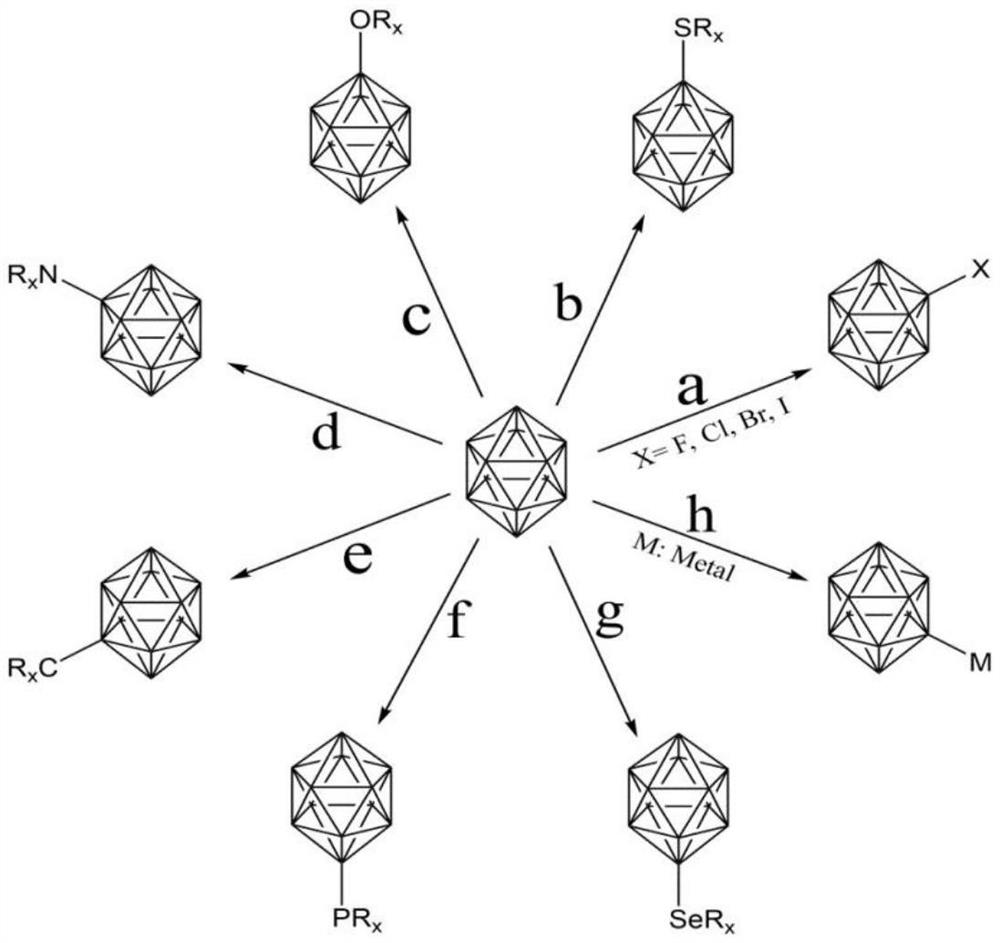Preparation method of photochromic material based on boron cluster anions
A photochromic material and anion technology, applied in the field of materials, can solve the problems of low quantum yield, small excitation wavelength, cumbersome synthesis, etc., and achieve the effects of low preparation cost, long free radical life, and high photosensitivity
- Summary
- Abstract
- Description
- Claims
- Application Information
AI Technical Summary
Problems solved by technology
Method used
Image
Examples
Embodiment 1
[0027] The preparation of several conjugated polypyridine molecules used in the present invention:
[0028] (1) Preparation of 2,4,6-tris(pyridin-4-yl)-1,3,5-triazine (TPT)
[0029] 4-cyanopyridine (6.0 g, 56 mmol) was added into a 100 mL three-necked flask and heated to 150° C. in an oil bath. Powdered NaOH (230mg, 5.6mmol) was added to the resulting liquid, and the mixture was kept at 150°C for 24h. After the reaction was completed, it was cooled to room temperature, and the solid was washed with a large amount of acetone and dissolved in 50mL of 4M hydrochloric acid. Activated carbon was then added and sonicated for 30 min. Filter the suspension with diatomaceous earth, and neutralize it with 2mol / L NaOH solution. At this time, a large amount of white precipitate will be produced. After filtering, wash it with a large amount of water and acetone alternately three times, and dry it in a 60°C oven. The product was obtained as a white solid (3.1 g, 52% yield).
[0030](2) P...
Embodiment 2
[0044] 0.624g (2mmol) of 2,4,6-tris(pyridin-4-yl)-1,3,5-triazine prepared in Example 1 was added into a 250mL round bottom flask containing 100mL ultrapure water, and then Adjust the pH to 0 with dilute hydrochloric acid, and stir ultrasonically at room temperature (25°C) until the solution is completely clear and transparent to obtain solution A; will contain 0.563g (3mmol) Na 2 B 12 h 12 50mL aqueous solution of the solution was added to solution A, and a light yellow precipitate was rapidly formed, and the stirring was continued for 30 minutes, and the precipitate was obtained by filtration, and washed three times with a small amount of water and ethanol respectively. The target product BOFs-TPT-H was obtained by vacuum drying. The excitation wavelength threshold for discoloration of the obtained target product is roughly between 460nm and 520nm, the photoresponse time is 3s, and the lifetime of free radicals is permanent at room temperature, and the free radicals disappe...
Embodiment 3
[0046] 0.624g (2mmol) of 2,4,6-tris(pyridin-3-yl)-1,3,5-triazine prepared in Example 1 was added into a 250mL round bottom flask containing 100mL of ultrapure water, and then Adjust the pH to 0 with dilute hydrochloric acid, and stir ultrasonically at room temperature (25°C) until the solution is completely clear and transparent to obtain solution A; will contain 0.563g (3mmol) Na 2 B 12 h 12 50mL aqueous solution of the solution was added to solution A, and a light yellow precipitate was rapidly formed, and the stirring was continued for 30 minutes, and the precipitate was obtained by filtration, and washed three times with a small amount of water and ethanol respectively. The target product was obtained by vacuum drying. The excitation wavelength threshold for discoloration of the obtained target product is approximately between 460nm and 520nm, the photoresponse time is 10s, and the lifetime of free radicals is permanent at room temperature, and the free radicals disappea...
PUM
 Login to View More
Login to View More Abstract
Description
Claims
Application Information
 Login to View More
Login to View More - R&D
- Intellectual Property
- Life Sciences
- Materials
- Tech Scout
- Unparalleled Data Quality
- Higher Quality Content
- 60% Fewer Hallucinations
Browse by: Latest US Patents, China's latest patents, Technical Efficacy Thesaurus, Application Domain, Technology Topic, Popular Technical Reports.
© 2025 PatSnap. All rights reserved.Legal|Privacy policy|Modern Slavery Act Transparency Statement|Sitemap|About US| Contact US: help@patsnap.com

